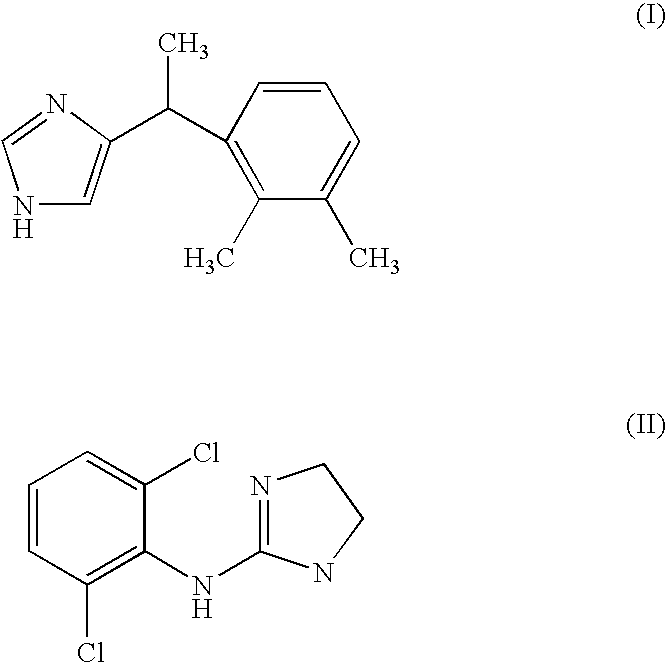Inhibition of marine biofouling of surfaces
a biofouling and surface technology, applied in the direction of biocide, plant growth regulator, animal husbandry, etc., can solve the problems of increasing fuel consumption, difficult to remove acorn barnacles by mechanical means from the surface on which they have attached themselves, and marine growth or biofouling is a considerable problem
- Summary
- Abstract
- Description
- Claims
- Application Information
AI Technical Summary
Benefits of technology
Problems solved by technology
Method used
Image
Examples
example 1
This example illustrates the settlement-inhibiting effect of one compound in accordance with the invention, medetomidine, on cyprid larvae. Cyprid larvae from Balanus improvisus were transferred to Petri dishes containing seawater from the Swedish west coast and medetomidine in various concentrations (0.1 nM, 1 nM, 10 nM, 100 nM and 1 .mu.M). In addition, for control purposes, cyprid larvae were transferred to a Petri dish containing seawater only. After 11 days the cyprids were counted and classified as either 1) settled (established) on the surface of the Petri dish, 2) swimming, i.e. living, not established, or 3) dead. The result is set forth in Table 1. The results in the table are expressed in percentage of the total number of organisms in each group (=n). From this experiment appears that the number of established larvae decreased upon increased concentration of medetomidine. The experiment also shows that the number of dead cyprids did not increase upon increased contents of...
example 2
This example corresponds to Example 1 with the exception that medetomidine was replaced by clonidine in the concentrations defined in Table 2 below. The results appear from Table 2.
example 3
This example shows the considerable tendency of medetomidine to bind to solid surfaces. Petri dishes of hydrophilic polystyrene were filled with a solution of medetomidine in varying concentrations (0 ng / ml 10 ng / ml, 1 .mu.g / ml and 10 .mu.g / ml). Like in Example 1, one Petri dish with no medetomidine was used as control. After a 24 hour incubation period in room temperature the dishes were cleaned thoroughly with seawater. The dishes were then incubated with cyprid larvae in amounts of approximately 20 larvae / dish. Readings were taken under microscope after 7 days, and the larvae were classified as either settled, free-swimming or dead. It is worth noting that a significant reduction of the number of settled acorn barnacles was found, also at very low medetomidine incubation concentrations.
PUM
| Property | Measurement | Unit |
|---|---|---|
| Fraction | aaaaa | aaaaa |
| Fraction | aaaaa | aaaaa |
| Fraction | aaaaa | aaaaa |
Abstract
Description
Claims
Application Information
 Login to View More
Login to View More - R&D
- Intellectual Property
- Life Sciences
- Materials
- Tech Scout
- Unparalleled Data Quality
- Higher Quality Content
- 60% Fewer Hallucinations
Browse by: Latest US Patents, China's latest patents, Technical Efficacy Thesaurus, Application Domain, Technology Topic, Popular Technical Reports.
© 2025 PatSnap. All rights reserved.Legal|Privacy policy|Modern Slavery Act Transparency Statement|Sitemap|About US| Contact US: help@patsnap.com

